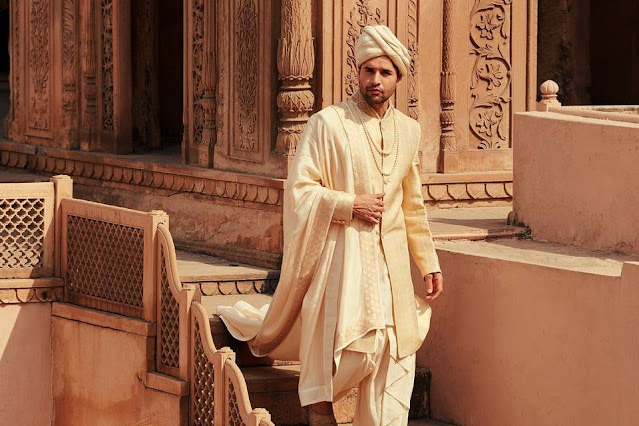The sherwani, a traditional Indian and Pakistani men's outfit, is not just a piece of clothing; it's a symbol of elegance, heritage, and regality.
This opulent attire has graced countless special occasions, from weddings to festive celebrations, and continues to be a timeless choice for those who seek to make a lasting impression.
In this blog, we delve into the rich history, design elements, and styling tips for the sherwani.
A Glimpse into the History
The sherwani has a storied history that dates back to the 19th century during the British colonial era in India.
It originated as a fusion of the British frock coat and traditional Indian attire. This amalgamation of styles resulted in a sophisticated, long, and close-fitting garment with exquisite embroidery and ornamentation.
Originally worn by nobility and aristocracy, the sherwani has since become a symbol of elegance and a staple at weddings and other significant celebrations.
Its enduring popularity can be attributed to the perfect blend of tradition and modernity, making it a cherished garment for grooms and attendees alike.
Design Elements of a Sherwani
Silhouette: The sherwani is characterized by its straight-cut silhouette that extends to the knees or lower, giving it a regal and imposing presence. The straight-line design is flattering to most body types.
Embroidery and Embellishments: Intricate embroidery and embellishments are the hallmark of a sherwani.
Traditional motifs, such as paisley, floral patterns, and Mughal-inspired designs, are painstakingly crafted by skilled artisans using techniques like zardozi, resham, and sequin work.
These embellishments often adorn the front, sleeves, and collar.
Fabric: Sherwanis are typically crafted from luxurious fabrics like silk, brocade, velvet, and satin. The choice of fabric often depends on the formality of the occasion.
Closure: Sherwanis traditionally have a button or hook-and-eye closure, which adds to their elegance. Modern variations may feature hidden zippers for convenience.
Nehru Collar: Many sherwanis are adorned with a Nehru collar, a stand-up collar that adds a touch of sophistication and complements the attire's clean lines.
Styling Your Sherwani
Matching Churidar or Straight Pants: Pair your sherwani with churidar pants or straight-cut trousers that complement the colors and style of your sherwani. The pants should be tailored to perfection, ensuring a sleek, sophisticated look.
Accessories: Elevate your sherwani look with the right accessories. A traditional safa (turban) or a stylish stole can add depth to your appearance. Don't forget to choose elegant shoes, like mojaris or juttis, to complete your look.
Color Choices: While traditional sherwanis are often seen in rich colors like maroon, gold, and royal blue, contemporary variations offer a wide range of color choices. Select a color that suits your skin tone and the occasion. Pastels and earthy tones have gained popularity in recent years.
Minimalistic or Elaborate: Choose the level of embellishment based on the event. Weddings and grand celebrations call for heavily embroidered sherwanis, while simpler, less ornate designs work well for more casual occasions.
Groom's Sherwani: If you're the groom, your sherwani should stand out. Opt for a color that complements your bride's attire and consider unique embellishments to make a statement.
In conclusion, the sherwani is a symbol of grandeur and tradition that has stood the test of time.
Whether you're a groom looking to make a lasting impression on your wedding day or a guest attending a special celebration, the sherwani offers an opportunity to embrace the rich cultural heritage of India and Pakistan while exuding timeless elegance and charm.
So, embrace the sophistication of the sherwani and be prepared to turn heads at your next special event.


No comments:
Post a Comment